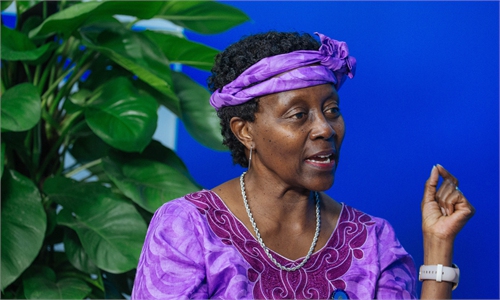Turning big ships
Climate-focused development banks neglect nature ahead of COP15
The world’s development banks could play a major role in protecting nature, but are largely ignoring biodiversity in a climate-led financing push, environmentalists warn, calling for action to fix the imbalance at December’s COP15 UN summit.
About 195 nations are tasked with finalizing a new accord to halt and reverse damage to plants, animals and ecosystems at the Wednesday-December 19 conference in Montreal, Canada.
The need for more financing for poorer nations, to help them meet new targets likely to be set at COP15, has long been a sticking point in the talks to hammer out a biodiversity pact, already hit by COVID-19 delays.
Multilateral development banks (MDBs) could do more in brokering an ambitious agreement on a new global biodiversity framework and implementing it, green groups said in a statement.
“MDBs are not where they should be. Their biodiversity portfolio is lagging behind their climate one,” said Li Shuo, a policy advisor at Greenpeace China.
“Whether more MDBs can commit to allocate more resources to the nature protection agenda will be a key test of the success of COP15,” he said in an interview.
Boosting conservation and management of natural areas, such as parks, oceans, forests and wildernesses, is seen as crucial to safeguarding the ecosystems on which humans depend and to limiting global warming to internationally agreed targets.
But forests are still being cut down – often to produce commodities such as palm oil, soybeans and beef – destroying biodiversity and threatening climate goals, as trees absorb about a third of planet-warming emissions produced worldwide.
Investments in protecting and better managing the world’s ecosystems must reach $384 billion a year by 2025, more than double their current levels, a UN Environment Programme report said this week.
MDBs must prioritize green finance and incentivize private investment, especially in sustainable supply chains, it added.
Momentum growing
Public development banks are owned by governments at international, regional and national levels, and their assets combined make up about 10 percent of global investment.
Most lend to nature-sensitive sectors – notably agriculture, mining and infrastructure – whose activities are often carried out in environments rich in biodiversity.
Researchers warned in 2021 that lending by public development banks could destroy nature worth $800 billion annually, and urged greater transparency to reduce the risks.
European Investment Bank (EIB) President Werner Hoyer said in November that he hoped the upcoming biodiversity summit would help MDBs accelerate their nature efforts.
An EIB spokesperson said the bank is committed “to protecting nature, forests and oceans,” citing its support for the Althelia Climate Fund which invests in sustainable land use.
The Asian Development Bank, which will participate in COP15, has “long supported environmental sustainability,” a spokesperson said, adding the bank had raised its climate finance goal for 2019-30 from $80 billion to $100 billion – and expects a significant share to go toward nature investments.
Examples of MDB nature finance include a hydropower project in the Solomon Islands with a biodiversity protection plan, backed by the World Bank and others, and a World Bank project in Sumatra, Indonesia, to curb emissions from forests and peatland by promoting sustainable fishing and alternative livelihoods.
Earlier in 2022, the Climate Investment Funds, one of the world’s largest climate finance instruments working with six major MDBs, launched a fund aiming to invest at least $500 million in protecting nature in developing countries.
Toerris Jaeger, head of the Rainforest Foundation Norway, said extensive funding was needed to protect remaining biodiversity hot spots – and MDBs have “a huge role” to play here, while ensuring their investments do not harm nature. Very few development banks have policies that are in line with government commitments on biodiversity, he noted.
In 2021, at the COP26 climate summit in Glasgow, a group of MDBs issued a statement recognizing the importance of nature and pledged to cooperate on bolstering biodiversity protection. Development banks, meanwhile, increased their climate-related financing by about a quarter to $82 billion in 2021, an October report by the lenders showed.
Margaret Kuhlow, finance lead at WWF International, urged MDBs to commit to step up their nature funding too, and align their investment approach with biodiversity protection, as they have promised to do with the Paris Agreement’s climate goals.
Traditionally for MDBs, biodiversity has always been a backwater issue, said Rod Taylor, global director for forests at the World Resources Institute, a US-based think tank.
Efforts by business to push leaders to force large companies to assess and disclose their impact on nature by 2030 will also boost transparency on where investments are made, he noted.
“Things like that can turn these big ships around because you are pricing the impacts on nature into those investments,” Taylor said.
Brian O’Donnell, director of the US-based Campaign for Nature, said until recently, multilateral banks had been a “no show” when it comes to financing biodiversity and instead focused heavily on climate after waking up to its importance.
For every dollar of climate financing they provide, MDBs put up only one to two cents for biodiversity, which adds up to no more than $1 billion a year for nature protection in low and middle-income countries, he noted. He urged the banks to start reporting on their biodiversity funding as they do for climate finance, while dramatically raising it to a similar level.
Reuters
About 195 nations are tasked with finalizing a new accord to halt and reverse damage to plants, animals and ecosystems at the Wednesday-December 19 conference in Montreal, Canada.
The need for more financing for poorer nations, to help them meet new targets likely to be set at COP15, has long been a sticking point in the talks to hammer out a biodiversity pact, already hit by COVID-19 delays.
Multilateral development banks (MDBs) could do more in brokering an ambitious agreement on a new global biodiversity framework and implementing it, green groups said in a statement.
“MDBs are not where they should be. Their biodiversity portfolio is lagging behind their climate one,” said Li Shuo, a policy advisor at Greenpeace China.
“Whether more MDBs can commit to allocate more resources to the nature protection agenda will be a key test of the success of COP15,” he said in an interview.
Boosting conservation and management of natural areas, such as parks, oceans, forests and wildernesses, is seen as crucial to safeguarding the ecosystems on which humans depend and to limiting global warming to internationally agreed targets.
But forests are still being cut down – often to produce commodities such as palm oil, soybeans and beef – destroying biodiversity and threatening climate goals, as trees absorb about a third of planet-warming emissions produced worldwide.
Investments in protecting and better managing the world’s ecosystems must reach $384 billion a year by 2025, more than double their current levels, a UN Environment Programme report said this week.
MDBs must prioritize green finance and incentivize private investment, especially in sustainable supply chains, it added.
Momentum growing
Public development banks are owned by governments at international, regional and national levels, and their assets combined make up about 10 percent of global investment.
Most lend to nature-sensitive sectors – notably agriculture, mining and infrastructure – whose activities are often carried out in environments rich in biodiversity.
Researchers warned in 2021 that lending by public development banks could destroy nature worth $800 billion annually, and urged greater transparency to reduce the risks.
European Investment Bank (EIB) President Werner Hoyer said in November that he hoped the upcoming biodiversity summit would help MDBs accelerate their nature efforts.
An EIB spokesperson said the bank is committed “to protecting nature, forests and oceans,” citing its support for the Althelia Climate Fund which invests in sustainable land use.
The Asian Development Bank, which will participate in COP15, has “long supported environmental sustainability,” a spokesperson said, adding the bank had raised its climate finance goal for 2019-30 from $80 billion to $100 billion – and expects a significant share to go toward nature investments.
Examples of MDB nature finance include a hydropower project in the Solomon Islands with a biodiversity protection plan, backed by the World Bank and others, and a World Bank project in Sumatra, Indonesia, to curb emissions from forests and peatland by promoting sustainable fishing and alternative livelihoods.
Earlier in 2022, the Climate Investment Funds, one of the world’s largest climate finance instruments working with six major MDBs, launched a fund aiming to invest at least $500 million in protecting nature in developing countries.
Toerris Jaeger, head of the Rainforest Foundation Norway, said extensive funding was needed to protect remaining biodiversity hot spots – and MDBs have “a huge role” to play here, while ensuring their investments do not harm nature. Very few development banks have policies that are in line with government commitments on biodiversity, he noted.
In 2021, at the COP26 climate summit in Glasgow, a group of MDBs issued a statement recognizing the importance of nature and pledged to cooperate on bolstering biodiversity protection. Development banks, meanwhile, increased their climate-related financing by about a quarter to $82 billion in 2021, an October report by the lenders showed.
Margaret Kuhlow, finance lead at WWF International, urged MDBs to commit to step up their nature funding too, and align their investment approach with biodiversity protection, as they have promised to do with the Paris Agreement’s climate goals.
Traditionally for MDBs, biodiversity has always been a backwater issue, said Rod Taylor, global director for forests at the World Resources Institute, a US-based think tank.
Efforts by business to push leaders to force large companies to assess and disclose their impact on nature by 2030 will also boost transparency on where investments are made, he noted.
“Things like that can turn these big ships around because you are pricing the impacts on nature into those investments,” Taylor said.
Brian O’Donnell, director of the US-based Campaign for Nature, said until recently, multilateral banks had been a “no show” when it comes to financing biodiversity and instead focused heavily on climate after waking up to its importance.
For every dollar of climate financing they provide, MDBs put up only one to two cents for biodiversity, which adds up to no more than $1 billion a year for nature protection in low and middle-income countries, he noted. He urged the banks to start reporting on their biodiversity funding as they do for climate finance, while dramatically raising it to a similar level.
Reuters



